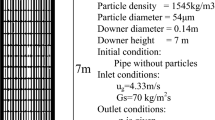Abstract
A two-scale second-order moment two-phase turbulence model accounting for inter-particle collision is developed, based on the concept of particle large-scale fluctuation due to turbulence and particle small-scale fluctuation due to collision. The proposed model is used to simulate gas-particle downer reactor flows. The computational results of both particle volume fraction and mean velocity are in agreement with the experimental results. After analyzing effects of empirical coefficient on prediction results, we can come to a conclusion that, inside the limit range of empirical coefficient, the predictions do not reveal a large sensitivity to the empirical coefficient in the downer reactor, but a relatively great change of the constants has important effect on the prediction.
Similar content being viewed by others
Abbreviations
- α p :
-
particle volume fraction
- β:
-
drag coefficient
- U :
-
mean velocity(m/s)
- u, v:
-
fluctuating velocity (m/s)
- uu, vv:
-
Reynolds stress or fluctuation velocity correlation(m2/s2)
- e:
-
restitution coefficient
- d :
-
particle diameter(m)
- k :
-
kinetic energy(m2/s2)
- ɛ:
-
kinetic energy dissipation rate(m2/s3)
- 1:
-
large-scale fluctuation
- 2:
-
small-scale fluctuation
- p:
-
particle
- f:
-
gas
References
Hanjalic K, Launder B E, Schiestel R. Multiple-time-scale concepts in turbulent transport modeling[M]. In: Bradbur L J S, et al (eds). Turbulent Shear Flows 2, Springer-Verlag, New York, 1980, 36–49.
Kim S W, Chen C P. A multiple-time-scale turbulence model based on variable partitioning of the time turbulent kinetic energy spectrum[J]. Numerical Heat Transfer, Part B, 1989, 16(2):193–211.
Cai Shutang, Liu Yulu. Turbulence Theory[M]. Shanghai Jiaotong University Press, Shanghai, 1993 (in Chinese).
Yamamoto M. Investigation of multiple-time-scale Reynolds stress model in homogeneous anisotropic turbulence[J]. Int J Heat Fluid Flow, 1995, 16(5):417–428.
Zhou Lihang. Dynamics of Multiphase Turbulent Reacting Fluid Flows[M]. National Defence Industry Press, Beijing, 2002 (in Chinese).
Yu Y, Zhou L X. A second-order moment two-phase turbulence model for dense gas-particle flows[C/CD]. In: Proc 5th Inter Conf on Multiphase Flow. ICMF’04. Tokyo Institute of Technology, Tokyo, 2004, Paper 161.
Wang Y, Bai D R, Jin Y. Hydrodynamics of cocurrent downflow circulating fluidized bed (CDCFB)[J]. Powder Technology, 1992, 70(3):271–275.
Author information
Authors and Affiliations
Corresponding author
Additional information
Communicated by LIU Yu-lu
Project supported by China Post-Doctoral Science Foundation(No.2004036239)
Rights and permissions
About this article
Cite this article
Hu, Cb., Zeng, Zx. Effect of empirical coefficients on simulation in two-scale second-order moment particle-phase turbulence model. Appl Math Mech 27, 1491–1497 (2006). https://doi.org/10.1007/s10483-006-1106-1
Received:
Revised:
Issue Date:
DOI: https://doi.org/10.1007/s10483-006-1106-1




